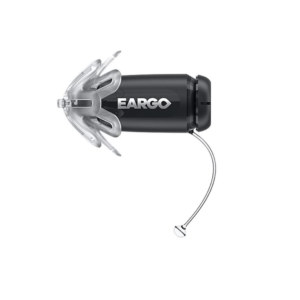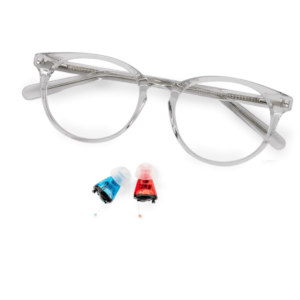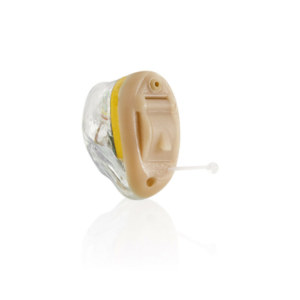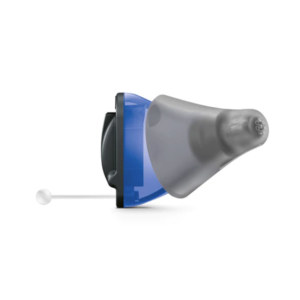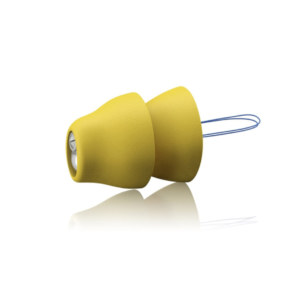5 Best Small Hearing Aids
AgingInPlace.org keeps our resources free by working as an affiliate partner with some companies mentioned on our site. These partnerships or the commission we may earn do not affect our opinions or evaluations of the products we mention. Our reviews are solely based on our research methodology and from input from our AgingInPlace.org Advisory Board. Learn more about our ad policies.
5 Best Small Hearing Aids
Products carousel
Less than 1 in 3 people who would benefit from hearing aids use them. Fear of stigmatization is a main driver of this behavior. Study participants with hearing loss noted concerns about looking old or unattractive while wearing hearing aids. Small hearing aids override this concern by being invisible, or nearly so.
- Small hearing aids are worn inside the ear.
- They can be invisible or practically invisible.
- Most small hearing aids cover mild to moderate hearing loss.
- People with severe or profound hearing loss may not benefit from small hearing aids.
- Many small hearing aids are unable to stream phone calls or media.
- Some have fewer features such as volume and memory controls.
Types of Small Hearing Aids
The smallest hearing aids available are those that sit fully or partially in the ear canal. Some are almost completely invisible. Others can be seen within the bowl of the outer ear, which leads to the ear canal. This part of the ear is called the concha.
Small hearing aids are often custom-made to fit exactly to your ear canal size and shape. People with the smallest ear canals may not be able to use these types of hearing aids.
Invisible In The Canal (IIC)
- IIC hearing aids are the least visible type of hearing aid.
- IIC hearing aids are placed deep inside the ear canal. They’re removed for cleaning and charging by the user with a small, attached string that sits in the concha.
- IIC hearing aids are too small to contain manual controls for volume or to change programs.
- They’re best for people with mild-to-moderate hearing loss.
Completely In The Canal (CIC)
- CIC hearing aids are sometimes referred to as mini-CIC.
- They are very discreet hearing aids that are hard to see.
- CIC hearing aids are best for people with mild-to-moderate hearing loss.
- CIC hearing aids are too small to accommodate more than one microphone.
- They may also have fewer special features, such as manual volume control.
In The Canal (ITC)
- ITC hearing aids are slightly larger than CIC hearing aids. They sit partly in the ear canal and partly in the bowl-shaped opening of the ear.
- ITC hearing aids are usually custom-made.
- They’re best for people with mild-to-moderate hearing loss.
In The Ear (ITE)
- ITE hearing aids are larger than IIC, CIC, and ITC hearing aids.
- Some are made with a half-shell design that fills only the bottom part of the concha. Others have a full-shell design that makes them more visible.
- Their larger size makes ITE hearing aids able to accommodate more than one microphone.
- They may also contain features that smaller hearing aids can’t, such as manual controls.
- ITE hearing aids are often a viable option for people with mild-to-severe hearing loss.
Why Trust Our Expert Review?
Our experts research and recommend products that can help give you a better quality of life. Using our high standards and rigorous testing methodology, we’ve spent more than 4,000 hours, collectively, researching the best hearing aids to help you find the device that’s best for you. Throughout our research process, we did the following:
- Consulted with audiologists and geriatric care experts
- Mystery shopped the brands
- Surveyed hundreds of hearing aid users
- Tested various models of hearing aids
- Interviewed experts in the field
- Read thousands of verified customer reviews from trusted sites such as Better Business Bureau and Consumer Reports
Small Hearing Aids to Consider
- Best for Small Ear Canals: Eargo 5
- Best Custom Fit: Audicus Aura
- Best Ready to Wear: Signia Silk NX
- Best Tinnitus Relief: Starkey Picasso Invisible in Canal
- Best Invisible Hearing Aid: Phonak Lyric
| BRAND | PRICE PER PAIR | TYPE OF HEARING AID | TYPE OF HEARING LOSS | RECHARGEABLE BATTERY | WARRANTY | RISK FREE TRIAL | BLUETOOTH CONNECTIVITY |
|---|---|---|---|---|---|---|---|
| Audicus Aura | $1,400 | CIC | Mild to moderately severe | No | 1 year | 45 days | No |
| Signia Silk NX | Varies by retailer | CIC | Mild to moderate | No | 1 year on average; varies by retailer | Varies by retailer | Yes |
| Eargo 5 | $2,500 | CIC | Mild to moderate in high frequency range | Yes | 2 years | 45 days | Yes |
| Phonak Lyric | Annual subscription cost varies by provider | IIC* | Mild to moderately severe | No | No | Available through some providers | No |
| Starkey Picasso | Varies by provider | IIC | Mild to moderately severe | No | Warranty covers loss, damage and hearing aid failure | 30 days | Yes |
| BRAND | ||||||||||||||||||||||||||||||||||||||||||||||||||||||||||||||||||||||||||||||||
| Audicus Aura | PRICE PER PAIR | $1,400 | TYPE OF HEARING AID | CIC | TYPE OF HEARING LOSS | Mild to moderately severe | RECHARGEABLE BATTERY | No | WARRANTY | 1 year | RISK FREE TRIAL | 45 days | BLUETOOTH CONNECTIVITY | No |
|---|
| Signia Silk NX | PRICE PER PAIR | Varies by retailer | TYPE OF HEARING AID | CIC | TYPE OF HEARING LOSS | Mild to moderate | RECHARGEABLE BATTERY | No | WARRANTY | 1 year on average; varies by retailer | RISK FREE TRIAL | Varies by retailer | BLUETOOTH CONNECTIVITY | Yes |
|---|
| Eargo 5 | PRICE PER PAIR | $2,500 | TYPE OF HEARING AID | CIC | TYPE OF HEARING LOSS | Mild to moderate in high frequency range | RECHARGEABLE BATTERY | Yes | WARRANTY | 2 years | RISK FREE TRIAL | 45 days | BLUETOOTH CONNECTIVITY | Yes |
|---|
| Phonak Lyric | PRICE PER PAIR | Annual subscription cost varies by provider | TYPE OF HEARING AID | IIC* | TYPE OF HEARING LOSS | Mild to moderately severe | RECHARGEABLE BATTERY | No | WARRANTY | No | RISK FREE TRIAL | Available through some providers | BLUETOOTH CONNECTIVITY | No |
|---|
| Starkey Picasso | PRICE PER PAIR | Varies by provider | TYPE OF HEARING AID | IIC | TYPE OF HEARING LOSS | Mild to moderately severe | RECHARGEABLE BATTERY | No | WARRANTY | Warranty covers loss, damage and hearing aid failure | RISK FREE TRIAL | 30 days | BLUETOOTH CONNECTIVITY | Yes |
|---|
*Requires professional insertion
Eargo 5 is a rechargeable, CIC hearing aid. It is Eargo’s smallest model to date. Like all Eargo hearing aids, you can purchase the Eargo 5 online, directly from the manufacturer.
High Frequency Hearing Loss: These hearing aids are for people with mild to moderate hearing loss in the high-frequency range. High frequency hearing loss is one of the most common types. It refers to high-pitched sounds. If you have trouble hearing birds chirping, you may have this type of hearing loss. High pitched hearing loss also makes it hard to discern children’s speech, and words that contain certain consonants, such as f, h, or s.
Small Ear Canals: Invisible hearing aids for small ear canals can be hard to find. If you were told you couldn’t wear discreet hearing aids, you may be able to wear the Eargo 5. They have a petal eartip design that makes them adaptable to smaller-sized ear canals.
Personalization: You can personalize your settings and volume through the Eargo app and your cell phone.
Eargo 5 costs $2,500 per pair online.
They come with a two-year warranty and a 45-day risk-free return trial.
See our full Eargo Hearing Aid Review.
The Aura is a CIC (completely in canal) hearing aid. They’re meant for people with mild to moderately severe hearing loss.
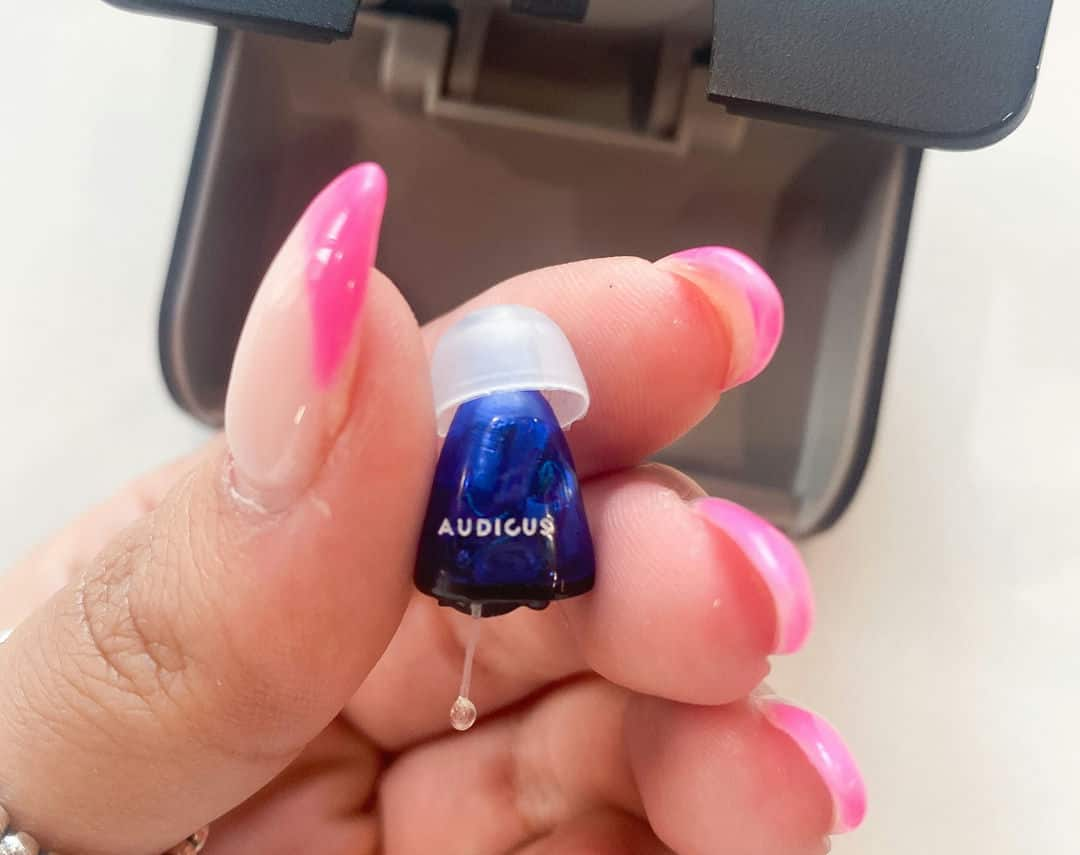
Customized Fit: If you are looking for a personalized fit, Aura may be a great choice for you. Aura hearing aids are custom-fit by a hearing professional, to mold exactly to the shape of your ear canals. They’re color-coded for your left and right ears, so you’ll never mistakenly put them in the wrong ear.
Battery: Aura uses small, disposable batteries, and may not be a good choice for anyone with hand dexterity issues. If you have arthritis, or any condition that affects your ability to grip and hold, rechargeable hearing aids will be better for you in the long run.
Bluetooth: These are not Bluetooth compatible and can’t be used for streaming. If you’re looking for hearing aids that will do double-duty for streaming phone calls or music, these won’t be your best option.
Competitive Pricing: Aura is competitively priced for custom fit hearing aids. You can purchase Aura hearing aids for around $1,400 per pair. They’re also available by monthly subscription.
Aura comes with:
- Two colored-coded hearing aids
- A carrying case
- A package of #10 batteries
- A cleaning brush
- Earwax guards
- Sized silicone domes for holding your hearing aids in place
Easy Volume Settings: They have four easy-to-adjust volume settings. Simply tap on either ear with a fully cupped palm.
Earwax Management: Wax buildup can be an issue for completely-in-canal hearing aids. To address this, Aura hearing aids come with earwax guards and a cleaning brush. Make sure you use these tools often, to avoid or eliminate wax buildup.
They come with a 12-month manufacturer’s warranty and a 45-day risk-free guarantee.
A protection plan that covers unlimited repairs can be purchased separately.
See our Full Audicus Hearing Aid Review.
These CIC hearing aids have click-on, flexible silicone sleeves that conform to the shape of your ear canal. This unique design makes them ready to wear without the need for a custom fitting.
Battery: Signia Silk NX uses disposable batteries and may pose the same types of issues with hand dexterity that other non-rechargeable hearing aids do.
They’re designed for people with mild to moderate hearing loss, which are common levels. According to the American Speech-Launguage-Hearing Association, the mild hearing loss range is 26 to 40 decibels and the moderate hearing loss range is 41 to 55 decibels.
Capable App: Audio streaming, remote control, and remote support are available 24/7 through the Signia app, which can be downloaded to your phone. If you don‘t have a smartphone, a Signia miniPocket accessory, purchased separately, can function as a remote control device.
How to Buy: Signia hearing aids are purchased through brick-and-mortar hearing aid retailers. For that reason, their cost, warranty, and trial period vary. Typically, Signia hearing aids come with a one-year warranty.
See our Full Signia Hearing Aid Review.
These custom-fit IIC hearing aids sit in the second bend of the ear canal. A tiny, bulb-headed wire sits in the outer ear and is used to remove each hearing aid for cleaning and charging. They rely on small, disposable batteries.
Controls: Due to their small size, these hearing aids may not be appropriate for people with severe hearing loss. Because of their small size, they don’t have manual volume or memory controls. Each hearing aid has a button that is programmed for volume or memory. Your audiologist will do the initial programming for you. If you choose to alter the volume or memory controls, you can do so when your hearing aid is out of your ear.
Super Feedback Cancellation: Starkey’s best-in-class feedback cancellation system eliminates buzzing and whistling, a huge plus. Users say they provide clear, crisp sound with no interference.
Audio Streaming: Because they’re so small, you’ll need to use Starkey’s Surflink accessories if you want to stream media and phone calls directly to your hearing aids. This makes it super easy to enjoy music, or listen to educational podcasts on-the-go.
Tinnitus Relief: These hearing aids can be customized for tinnitus relief. Tinnitus (ringing in the ears) often accompanies hearing loss. According to the Mayo Clinic, tinnitus is a common condition that affects up to 20% of people. Hearing aids aren’t a cure for tinnitus, but can provide relief.
Starkey makes it easy for you to try these hearing aids. They come with a 30-day risk-free trial. If they don’t work for you you can return them for a full refund and no questions asked.
Starkey Picasso hearing aids are available in five technology levels. According to the manufacturer, the technology level of the hearing aids you choose will determine the warranty you receive. Your warranty may also vary from provider to provider. At the very least, you can expect to get Starkey’s “worry-free” manufacturer’s warranty which covers loss, damage, and hearing aid failure.
Cost varies per provider. Financing options are available.
See our full Starkey Hearing Aid Review.
Phonak Lyric hearing aids are completely invisible, with no strings or outer parts. They’re made from a soft, pliable material that molds itself perfectly to your ear canal shape.
These hearing aids can be worn comfortably by people with mild to moderately severe hearing loss.
Visit your Hearing Professional: You’ll need to see a Phonak hearing professional to get Phonak Lyric hearing aids. They’re inserted deep into the ear canal by a specialist who is trained for this purpose. Fitting, programming, and insertion take about an hour. This is done through a non-surgical procedure, which is not painful.
Wearing Your Lyric
Phonak Lyric hearing aids can remain in your ears for months at a time. If needed, you can remove them at home with a special tool your audiologist will give you. However, you won’t be able to reinsert Lyric on your own.
Unlike other hearing aids, these can be worn while showering and sleeping. They’re water-resistant, but not waterproof, so don’t immerse your head completely underwater while wearing Lyric. If you’re a swimmer, these won’t be a good choice for you, as they shouldn’t be worn in a pool.
Connectivity: They’re not Bluetooth compatible and can’t be used for streaming.
Lyric hearing aids are available by subscription only. A one-year subscription includes new devices every two-to-three months. It also includes repairs if needed, plus batteries and technology updates.
Read our in-depth look at Phonak hearing aids.
Small Hearing Aid Pros and Cons
Small hearing aid pros and cons vary from model to model. Some pros and cons include:
Pros
-
Discreet and hard to see
-
Less wind noise generation
-
No external parts that interfere with glasses
Cons
-
Small batteries can be hard to change
-
Shorter battery life
-
Not for severe or profound hearing loss
-
May not be sized for smaller ear canals
-
May lack bluetooth streaming
-
May include fewer features, such as volume control
-
Susceptible to wax buildup
Difference Between Traditional and Small Hearing Aids
Traditional hearing aids are worn partially inside and partially outside the ear. These include BTE and receiver-in-canal (RIC) styles. As with small hearing aids, BTE and RIC styles have become more streamlined and discreet than they were years ago.
Unlike small hearing aids, traditional hearing aids have a hard plastic case worn behind the ear. The case connects to a plastic earmold within the ear. The outer portion houses the hearing aid’s microphone and other electronic components. This case is usually available in a variety of hues you can match to your hair color, for discretion.
A hearing specialist can help you determine the type of hearing aid that is best for your hearing loss.
Maintenance, Warranty, and Care
Warranty – Warranties vary by company and may also be determined by the retailer. Most warranties are for one or two years. In some instances, you may be able to buy a purchase protection plan for your small hearing aids.
Cleaning – In-ear hearing aids are prone to wax buildup. Many come with a wax removal tool you can use. It’s important to keep small hearing aids clean so you don’t compromise the quality of sound they produce.
Storage – Except for Phonak Lyric hearing aids, which are not meant to be removed, small hearing aids come with a storage case. Rechargeable models come with a case that stores and charges them simultaneously.
Charging – Most small hearing aids rely on disposable batteries, such as #10s, for power. These have a short battery life of three to seven days.
Water-resistance – Hearing aids are water-resistant, not waterproof. Except for Lyric, you shouldn’t wear hearing aids while showering. No hearing aids should be worn when your head is immersed in water.
Returns – Return policies vary. Most hearing aid manufacturers offer a 45-day risk-free trial.
Our Criteria for Choosing the Best Small Hearing Aids
We consulted audiologists and geriatric care experts in addition to independently testing various models. We read thousands of verified customer reviews and conducted exhaustive research.
Through this in-depth research, we determined the following to be the most important criteria to consider when shopping for a hearing aid:
- Price
- Types of hearing aids available
- Types of battery used
- Quick-charge options
- Types of hearing loss covered
- Bluetooth compatibility
- Audiologist care
- Comfort and fit
- Warranty
- Customer satisfaction
- Customer service
- Features such as bluetooth capability and rechargeable batteries
- Reliability
Bottom Line
Small hearing aids are worn inside the ear canal. There are several styles and levels of invisibility.
Small hearing aids usually cover mild to moderate hearing loss. Even though the sound quality they produce is crisp, they may not provide enough amplification for people with severe or profound hearing loss.
Their small size also may eliminate special features that are important to you, such as Bluetooth compatibility.
When choosing hearing aids, weigh their pros and cons against your wish list. If discretion is the most important attribute you’ve identified for hearing aids, small hearing aids may be your perfect fit.
Frequently Asked Questions
-
Most CIC hearing aids use disposable batteries. This can be challenging for people with hand dexterity issues. The Eargo 5 is a rechargeable CIC hearing aid you may wish to consider.
-
ITE hearing aids are not usually a good choice for severe or profound hearing loss. They’re also prone to wax buildup and require cleaning often. Many brands can’t be used for streaming.
-
Currently, the most invisible hearing aid is Phonak Lyric. It is inserted very deep into the ear canal by an audiologist. Unlike invisible-in-the-canal (IIC) or CIC hearing aids, they have no visible pull string for manual removal.
-
That depends on your hearing loss level and type as well as your personal preferences. If you have mild to moderate hearing loss, they may be a better choice for you than traditional hearing aids in some instances.
-
IIC hearing aids are the smallest type.
Other Hearing Aids Guides
- Best Hearing Aids
- Best Small Hearing Aids
- Best Invisible Hearing Aids
- Best Over-The-Counter Hearing Aids
- Best Hearing Aids for Tinnitus
- In-The-Ear Hearing Aids Review
- Best Rechargeable Hearing Aids
- Best Bluetooth Hearing Aids
- Best Cheap Hearing Aids
- Best TV Listening Aids for The Hearing Impaired
- Best Hearing Amplifiers
Learn More About Hearing Aids
WRITTEN BY
Corey Whelan is a writer, health care professional, and Brooklyn, New York native. She is a reproductive health advocate who has helped countless patients through the trials and triumphs of infertility and adoption over the past 25 years. Corey's passion is sharing her knowledge of health and wellness through her writing, and no topic is off limits. She's mom to two grown children and two rescue dogs who captured her heart.
View Author- Christy, Starkey phone support operator. Telephone interview. November 23, 2021
- Degree of hearing loss. (n.d.).
- Miller, M. Telephone interview. November, 2021).
- Quick statistics about hearing. (2021).
- Mayo Clinic Staff. Tinnitus. (2021).
- Ritter CR, Barker BA, Scharp KM (2020) Using attribution theory to explore the reasons adults with hearing loss do not use their hearing aids. PLoS ONE 15(9): e0238468.
- Types of hearing aids (2018).
Do you want to cite this page? Use our ready-made cite template.

